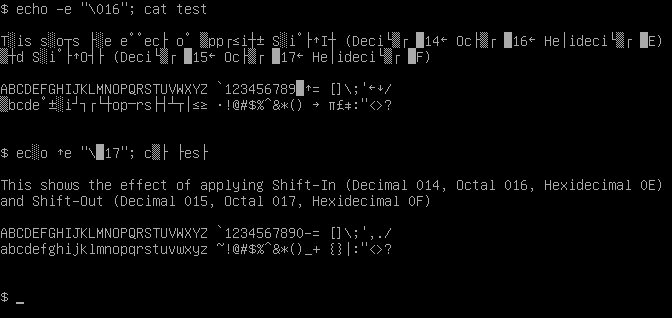Shift In on:
[Wikipedia]
[Google]
[Amazon]
 Shift Out (SO) and Shift In (SI) are
Shift Out (SO) and Shift In (SI) are
 Shift Out (SO) and Shift In (SI) are
Shift Out (SO) and Shift In (SI) are ASCII
ASCII ( ), abbreviated from American Standard Code for Information Interchange, is a character encoding standard for electronic communication. ASCII codes represent text in computers, telecommunications equipment, and other devices. Because ...
control character
In computing and telecommunication, a control character or non-printing character (NPC) is a code point (a number) in a character set, that does not represent a written symbol. They are used as in-band signaling to cause effects other than the ...
s 14 and 15, respectively (0x0E and 0x0F). These are sometimes also called "Control-N" and "Control-O".
The original meaning of those characters provided a way to shift a coloured ribbon, split longitudinally usually with red and black, up and down to the other colour in an electro-mechanical typewriter
A typewriter is a mechanical or electromechanical machine for typing characters. Typically, a typewriter has an array of keys, and each one causes a different single character to be produced on paper by striking an inked ribbon selectivel ...
or teleprinter
A teleprinter (teletypewriter, teletype or TTY) is an electromechanical device that can be used to send and receive typed messages through various communications channels, in both point-to-point and point-to-multipoint configurations. Init ...
, such as the Teletype
A teleprinter (teletypewriter, teletype or TTY) is an electromechanical device that can be used to send and receive typed messages through various communications channels, in both point-to-point and point-to-multipoint configurations. Init ...
Model 38, to automate the same function of manual typewriters. Black was the conventional ambient default colour and so was shifted "in" or "out" with the other colour on the ribbon.
Later advancements in technology instigated use of this function for switching to a different font
In metal typesetting, a font is a particular size, weight and style of a typeface. Each font is a matched set of type, with a piece (a " sort") for each glyph. A typeface consists of a range of such fonts that shared an overall design.
In mo ...
or character set
Character encoding is the process of assigning numbers to graphical characters, especially the written characters of human language, allowing them to be stored, transmitted, and transformed using digital computers. The numerical values tha ...
and back. This was used, for instance, in the Russian character set known as KOI7-switched, where SO starts printing Russian letters, and SI starts printing Latin letters
The Latin script, also known as Roman script, is an alphabetic writing system based on the letters of the classical Latin alphabet, derived from a form of the Greek alphabet which was in use in the ancient Greek city of Cumae, in southern ...
again. Similarly, they are used for switching between Katakana
is a Japanese syllabary, one component of the Japanese writing system along with hiragana, kanji and in some cases the Latin script (known as rōmaji). The word ''katakana'' means "fragmentary kana", as the katakana characters are derived f ...
and Roman letters in the 7-bit version of the Japanese JIS X 0201.
SO/SI control characters also are used to display VT100
The VT100 is a video terminal, introduced in August 1978 by Digital Equipment Corporation (DEC). It was one of the first terminals to support ANSI escape codes for cursor control and other tasks, and added a number of extended codes for special ...
pseudographics. Shift In is also used in the 2G variant of SoftBank Mobile's encoding for emoji
An emoji ( ; plural emoji or emojis) is a pictogram, logogram, ideogram or smiley embedded in text and used in electronic messages and web pages. The primary function of emoji is to fill in emotional cues otherwise missing from typed conv ...
.
The ISO/IEC 2022 standard ( ECMA-35, JIS X 0202) standardises the generalized usage of SO and SI for switching between pre-designated character sets invoked over the 0x20–0x7F byte range. It refers to them respectively as Locking Shift One (LS1) and Locking Shift Zero (LS0) in an 8-bit environment, or as SO and SI in a 7-bit environment. In ISO-2022-compliant code sets where the 0x0E and 0x0F characters are used for the purpose of emphasis (such as an italic or red font) rather than a change of character set, they are referred to respectively as Upper Rail (UR) and Lower Rail (LR), rather than SO and SI.
See also
*C0 and C1 control codes
The C0 and C1 control code or control character sets define control codes for use in text by computer systems that use ASCII and derivatives of ASCII. The codes represent additional information about the text, such as the position of a curso ...
References
{{Reflist Control characters